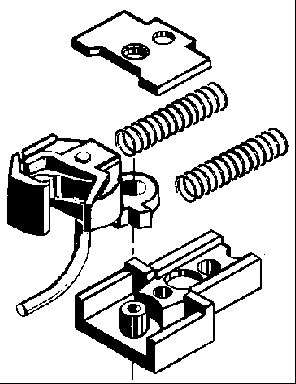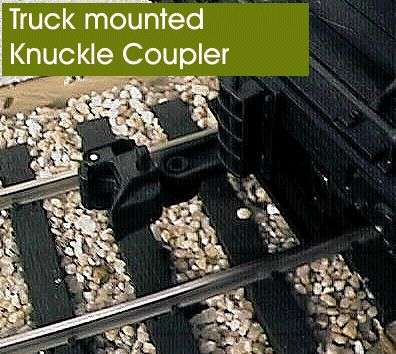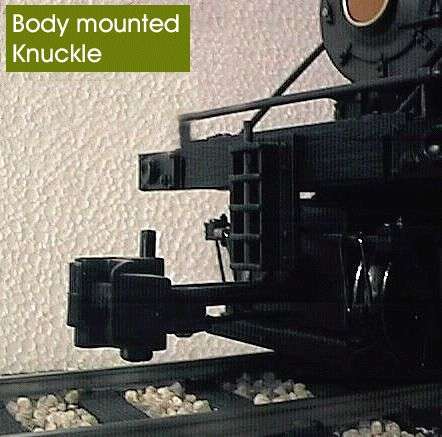Scratch & Bash
:
Engines / Rolling Stock
Large Scale Couplers Today
Jul 4, 2007


By Rick Henderson
LSOL.com Associate Editor |
Author
Bio
Coupling your trains in large scale model railroading can be an interesting misadventure. Those that are new to the world of large scale may not realize there is more than one type of coupler out there while seasoned modelers canít believe the mess on our hands.
|
 |
Coupling your trains in large scale model railroading can be an interesting misadventure. Those that are new to the world of large scale may not realize there is more than one type of coupler out there while seasoned modelers canít believe the mess on our hands. There are about as many ways to couple your trains as there are manufacturers out there. But donít feel bad, in the early days of US railroading, all couplers would not match. |
Actually, in large scale railroading, there is not a perfect all around coupler that will fit every situation for every person. What you choose to use will depend on a number of factors; link & pin, knuckle, loop & hook, body mount or truck mount, the radius of your curves, crossovers and S curves, which of the 5 large scales you model, uncoupler ramps, track condition, car lengths, etc. The list goes on.
Donít get frustrated just yet, there are other considerations. Where will you run your trains? At home like most people or with a local large scale club or module group/ Will friends bring their stuff to your place to run mixed with your trains? Will you actually be operating and switching out cars or just running in circles? Do you care how realistic it looks? Finally, do you care what the couplers look like?
The answer to the above questions will vary a great deal with each person so the end results will not be the same. Welcome to large scale railroading.
Where to start? Actually you donít start with the engine or car, you first determine where you will run your trains and in what scale. If you are going to be with a club or group of other people occasionally, start with them and see what their standard club couplers are. No use putting on USA hook & loops if your friends all use Bachmann knuckle couplers.
Body vs. Truck Mounting: Now it can get a little more complicated. Prototype couplers are mounted centered on the end of a car frame. Some are flush mounted, some extend past the end of the car but they are all body mounted. In model railroading, manufacturers usually mount couplers to arms extending off the trucks under and out the end of the body. This is so cars will track better on the sharp curves normally used.
Body mounted couplers look much better and actually work better because the weight of the train being pulled is passed directly through the body of the car and not through the trucks. This allows the trucks to track better on the rails without the influence of the next car directly controlling their motion. Body mounted is ideal but only works if you have very wide radius curves, turnouts and crossovers. Note that the 48" radius turnout {a-k-a R3} is actually too sharp for all body mounted couplers to work on. Why? Because the distance from the center of the truck to the end of the car body varies on different lengths of cars.

 | This creates a different overhang [in this case, the distance from the center of the car varies from the center of the track on a curve] at the end of cars. Couplers on cars with greatly different overhangs will not line up on curves and can often cause a derailment because one car pulls the other car off the track. This often happens on crossovers where you have two turnouts on parallel tracks used to change tracks. In the center of the crossover, one car will be off center one direction while the other car is forced the opposite direction. If you choose body mounted couplers, all of your curves will have to be very wide, especially the curves on your crossovers. |
If you use truck mounted couplers then they will track better through the sharper curves and crossovers. However, they are more prone to derailment due to the entire drag of the train passing through the trucks. This drag weight often is a contributing factor to car derailments close to the locomotive power. Youíll need to run shorter trains.
The Couplers: There are actually several types of couplers that manufacturers include with their trains, and they donít all work together. In fact, depending on the quality control of the manufacturer, their own couplers may not consistently work with each other. An important factor in determining what will work for you is your track work. Outside layouts tend to be a little rough, okay some look down right prototypically bad. Unfortunately, model railroads require better track conditions than real railroads for the most part.
Link and pin couplers are just that. Each car has a coupler pocket with a hole in the top running through to the bottom. An oval shape steel link is inserted into the pocket and then the pin is dropped into the hole and through the bottom, locking the link into the pocket. The car is then pushed against the next car as the exposed end of the link is guided into the pocket on the next car. Once in the pocket, the pin on that car is dropped into place and the cars are coupled. These type of couplers were used in the early days of US railroading and extensively on logging railroads
Knuckle couplers are what are used today in railroading and are offered in a variety from large scale manufacturers. The top of the line is the after market [you install] Kadee Quality Couplers. These authentic looking, operating couplers are for those that want to actually operate their railroad with switching or want a more realistic looking coupler. With large flat magnets placed between the rails, you can actually uncouple and move a car into a siding with a few forward and reverse motions of your locomotive and never touch the car.
Several manufacturers make plastic knuckle couplers and include them with their car and engines. Most have a tendency to require a hard hit between cars to couple and also do not always stay coupled. When it comes to knuckle couplers, you get what you pay for. The draw back is no knuckle coupler likes real rough unleveled track. If the coupler heights are slightly different to start with and your train crosses a hump or dip in the track, one coupler may slip above the other causing an unwanted uncoupling. While no track should be allowed to get into this rough condition, it does happen
Knuckle couplers that come from various manufacturers do not always work well with other manufacturers' knuckle couplers. If you decide on a knuckle coupler your best bet is to convert all your equipment to that one coupler or make a transition car as explained a little later
Loop & Hook: These couplers have no real prototype. They are designed for toy trains, rough track and young children. They couple easily and usually stay together well. They consist of loops extending from each end of the car, usually attached to the trucks. One end and sometimes both ends also have a hook that is spring loaded under the loop and extend beyond to catch the loop on the next car. Varieties of this coupler are supplied with over half the cars in the hobby today. If your track leans towards the rough end, and you donít care to upgrade it, you may need these
Transition Cars: If you decide that you want a different standard of couplers than the people you want to run trains with, all is not lost. You can make up what we call a transition car with your favorite style of couplers on one end and their favorite style on the other end. A simple solution except that is the only thing you can use that car for.
Coupler Standards: Ha, not in large scale yet. This is due to the fact that there are 5 different large scales. The size variance from 1:32 scale to 1:20.3 scale is 36.5% meaning 1:20.3 is 36.5% larger than 1:32. This can greatly affect the height of a coupler above the rail if both scales were to use accurate size trucks. To compensate for this variation, manufacturers may make one size of car and paint it different names to mutate from standard and narrow gauge thus using the same size trucks and couplers. Recently, some manufacturers have improved their own lines and are producing more accurately scaled items but we have a long way to go.
Kadee couplers come in two sizes for large scale. A #1 used for 1:32 & 1:29 scales and a larger ĎG Scaleí used for 1:20 & 1:22. Modelers in 1:24 can use either one however the #1 would be more to scale. They also make a coupler gauge to check your cars coupler position to be sure all coupler heights are uniform. When converting USA Trains and LGB cars to truck mounted Kadee couplers they usually are already at the correct height for this coupler gauge.
That is the bulk of the basic information on the majority of the couplers available today. Now you should be informed enough to make a decision that will work for your railroad.Top of Page
|



